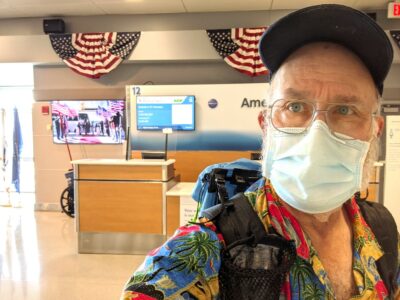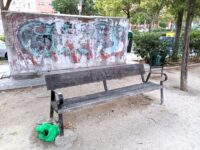August 2, 2021

My Camino Day 7/28 to 8/2 2021 – My journey from the normalcy of home to Washington to New York to Madrid and on to Zumaia.
An explanatory note
Working to clean up and organize this site, I discovered that this post has much of the same material as an older one, My Camino Day 2021 – getting there. Each of the two does have unique material, but there is also a lot of overlap. They were written a year or more apart and any conflicts between the two are tricks of my memory or the result of added efforts such as fully transcribing my 2021 Camino journal.
In thinking about how to handle this duplication, several conversations with my Camino friends, people I’ve met along The Way, came back to me. They argued, quite persuasively, that one’s Camino beings at one’s door. In a few cases, my Camino friends explained that they had begun their Camino Journey by leaving home with their backpack and walking toward the nearest of the many Camino routes that exist in Europe.
Beginning my own Camino at my door in the same way is not possible because the Atlantic Ocean lies between me and every European Camino route. Despite this limitation, this post (and My Camino Day 2021 – getting there) attempt a similar story, one in which each leg of my Camino Journey begins at home with an intermediate destination of where the prior leg of my Journey had ended.
Home
 My Camino day(s) spent getting from normal life—call it home—to where the 2021 leg of my Camino Journey would begin at the same place the 2018 leg ended—the small Spanish town of Zumaia—should probably begin with my last practice hike on July 28th, a total of 11.8 kilometers (a bit over 7 miles). The hike was along the Muddy Branch Trail, which passes within a mile or so of my home. It provides a convenient, modestly similar, but not terribly challenging practice hike that includes a little terrain—75 meters (240 feet) up and down—and practice on unpaved surfaces.
My Camino day(s) spent getting from normal life—call it home—to where the 2021 leg of my Camino Journey would begin at the same place the 2018 leg ended—the small Spanish town of Zumaia—should probably begin with my last practice hike on July 28th, a total of 11.8 kilometers (a bit over 7 miles). The hike was along the Muddy Branch Trail, which passes within a mile or so of my home. It provides a convenient, modestly similar, but not terribly challenging practice hike that includes a little terrain—75 meters (240 feet) up and down—and practice on unpaved surfaces.
Practice and training are important, make that critical. El Camino de Santiago is a physical challenge that anyone must be ready for. That goes ten times, not double, ten times, for senior pilgrims.
Hikes such as this one, which were shorter than the daily plan in Spain and required only a fraction of the climbing, were the best easily available. Good, yes. Truly adequate, no. Time and again, the lesson to train as hard as possible has been given to me, yet, somehow, it never seems to stick as well as might be hoped.
Home to Washington to New York to Madrid
 On July 31st, I boarded a flight at the Ronald Reagan Washington National Airport that took me to the John F. Kennedy International Airport in New York City where I transferred to my flight to Madrid. It turned out that the gate my flight used is the same one used for Honor Flights. The gate was decorated with bunting.
On July 31st, I boarded a flight at the Ronald Reagan Washington National Airport that took me to the John F. Kennedy International Airport in New York City where I transferred to my flight to Madrid. It turned out that the gate my flight used is the same one used for Honor Flights. The gate was decorated with bunting.
The Honor Flights take veterans, primarily of the Second World War, to Washington to see the various memorials that honor their service. The flights are met by groups to honor the veterans with live bands and salutes from active-duty service members and other veterans. Seeing this happen in Washington, and the reactions from the veterans, often elderly and infirm, which it has been my good luck to have experienced, is extremely affecting and absolutely wonderful.
The flight to Spain was packed. The passengers all wore surgical masks in honor of the danger posed by the COVID-19 pandemic even though all of us had passed a COVID-19 test only hours before boarding the flight. The guidance for these tests was that an all clear was required but the choice of test, Polymerase Chane Reaction (PCR) or Antigen, was ill defined. I chose the PCR test, it was more expensive, to avoid any question that might arise at the airport. That turned out to be truly unnecessary as nobody seemed particularly concerned or checking COVID test paperwork.
One surprise was seeing medical setups in the Barajas arrival area. These temporary operations were providing COVID Antigen tests for people arriving in Madrid who had not been tested before boarding their flight. This seemed odd to me, given the United States’ requirement to be tested before boarding, but the whole pandemic experience was still a bit new in the summer of ’21.
Madrid

 I arrived at Barajas Airport, the main airport in Madrid, early on August 1st. That left me a bit disoriented by jet lag, hungry, and very tired.
I arrived at Barajas Airport, the main airport in Madrid, early on August 1st. That left me a bit disoriented by jet lag, hungry, and very tired.
I chose the Airbnb location for a combination of low price and its nearness to the Chamartín Train Station in Madrid. It did not allow me to check in before 3 PM Madrid time, so it was necessary to find a way to fill the hours. My solutions included a nice nap on a park bench (Yes, that’s the bench) and some of the delicious food that is available everywhere in Spain at a restaurant near the Airbnb.
Madrid to Zumaia
 It was at Chamartín that I caught the Renfe train to San Sebastian on August 2nd. From there, the local narrow-gauge train took me back to Zumaia.
It was at Chamartín that I caught the Renfe train to San Sebastian on August 2nd. From there, the local narrow-gauge train took me back to Zumaia.
I was back—back as I had promised myself I would be as I stood on the Zumaia platform in 2018—but in very, very different circumstances. My taste of el Camino then had been a tiny one. Everything was open. There was no health crisis. I had my “host family” and the Lacunza school‘s resources to fall back on. Only one night had lacked an assured bed indoors and any forecast of rain could be met by not hiking that day.
Now, things were very different. There was no host family to care for me, no base of operations in San Sebastian that would always provide a bed for the night, everyone was masked—and fearful—because of the pandemic, and many places that help a peregrino along The Way—hostels, restaurants, bars, albergues—were closed. There was much about the coming days—the inconveniences I would have to accept, the challenges I would have to overcome, and the pandemic induced dangers that I would have to face—about which I had no way of knowing.
To say that worried me as I exited the train at the Zumaia station is an understatement.
Arriving in Zumaia
 But I was back—back as I had promised myself I would be—and that was all that mattered as I left the train station and began walking. Very shortly, I was searching for the Airbnb location where I would spend the next two nights. It was down that very small lane, Mari Kelea, to the left of the church, and a little difficult to find. It was, however, a fabulous setup for an older, jetlagged, pilgrim and I would enjoy its views of the harbor and the comfort of its setup for the archetypal “three days and two nights” before venturing on.
But I was back—back as I had promised myself I would be—and that was all that mattered as I left the train station and began walking. Very shortly, I was searching for the Airbnb location where I would spend the next two nights. It was down that very small lane, Mari Kelea, to the left of the church, and a little difficult to find. It was, however, a fabulous setup for an older, jetlagged, pilgrim and I would enjoy its views of the harbor and the comfort of its setup for the archetypal “three days and two nights” before venturing on.
But that’s another story and another post.
